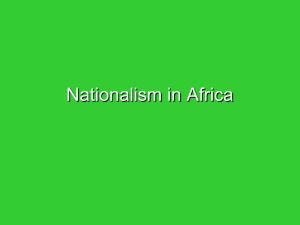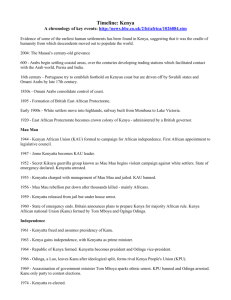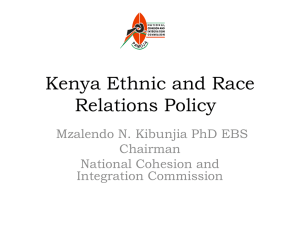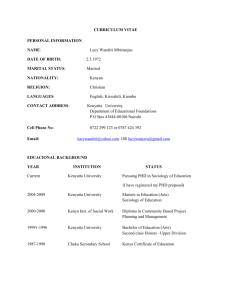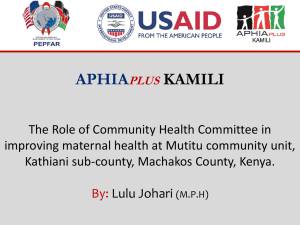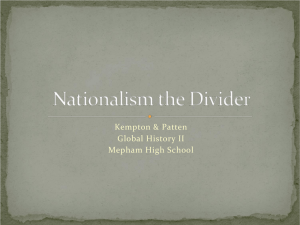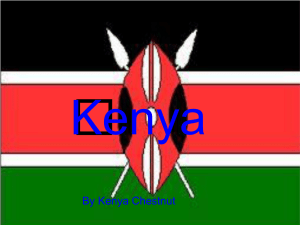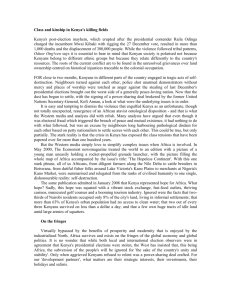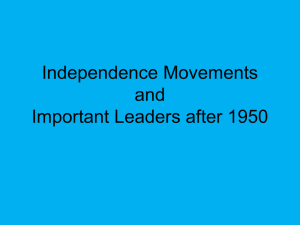the politics of ethnicity, national resources and media biases in
advertisement
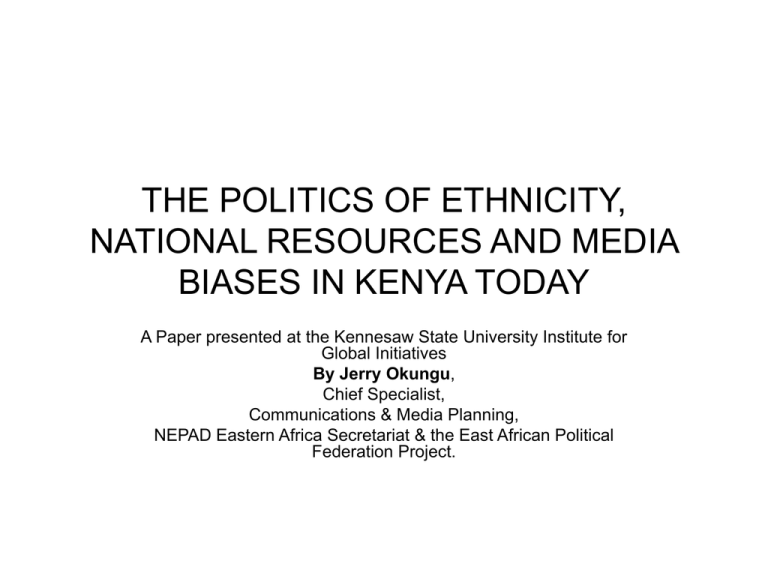
THE POLITICS OF ETHNICITY, NATIONAL RESOURCES AND MEDIA BIASES IN KENYA TODAY A Paper presented at the Kennesaw State University Institute for Global Initiatives By Jerry Okungu, Chief Specialist, Communications & Media Planning, NEPAD Eastern Africa Secretariat & the East African Political Federation Project. MANAGING DIVERSITY: KENYA’S 21ST. CENTURY CHALLENGE • Background to the struggle for independence and the unity of purpose then • Kenyans expectations and dreams of a paradise state following independence • Failed dreams and un-kept promises that turned into despair and desperation • Ethnic fallouts and political realignments soon after Uhuru DIVERSITY DILEMMA • The Shifta War in Northern Kenya waged by the Somali Community for a number of years. • The eating culture that ushered in high level corruption in government also encouraged nepotism and ethnic biases in appointments to public offices • Communities and individuals that were able to raise concerns over these vices were seen as anti-establishment and therefore anti- the ethnic community that enjoyed the presidency DIVERSITY DILEMMA.. • The biggest fallout occurred in 1966 when President Kenyatta parted ways with his first Vice President, Jaramogi Oginga Odinga. • The Vice President went on to form his political party that became the first opposition party in parliament after Kenya African Democratic Union was persuaded to join the ruling party, KANU in 1964. DIVERSITY DILEMMA.. • With the political assassination of Pio Gama Pinto in 1965 and Tom Mboya in 1969, coupled with the banning of Jaramogi Oginga Odinga’s Kenya People’s Union( KPU) just three months after Mboya’s death, the stage was now set for an ethnic biased regime that became less and less tolerant as Kenyatta grew older. DIVERSITY DILEMMA • In the last days of Kenyatta, it was a treasonable offence, punishable by law to “imagine, encompass or dream of the death of the President!” • Voices of dissent in and out of Parliament were silenced through intimidation, bribery, detentions without trial or organized assassinations. DIVERSITY DILEMMA • In this category can be found, Jaramogi Oginga Odinga, Achieng Oneko, Marie Seroney, Martin Shikuku, Philomena Chelagat, Wasonga Sijeyo, Professor Ouma Muga , Ngugi Wa Thiong’o, Maina Kinyati, Anyang’ Nyong’o and JM Kariuki among many more prominent Kenyans in politics and academia. DIVERSITY DILEMMA • Before Kenyatta died in 1978, the entire Kenyan economy, public service and political establishment was the preserve of one ethnic community. • The joke Kenya at the time was that at times Cabinet meetings could be conducted in the President’s ethnic language • The Financial sector, the engine of economic growth was in the hands of the same ethnic community DIVERSITY DILEMMA • The only three media houses i.e. Voice of Kenya, The East African Standard and the Daily Nation were dominated by the same ethnic ruling class • Every news bulletin and headline picture began with “ His Excellency President Jomo Kenyatta” to the extent that synics started referring to Voice of Kenya as Voice of Kenyatta or Voice of Kikuyus DIVERSITY DILEMMA • This was the political scenario that Kenya’s second President inherited from Jomo Kenyatta upon his death • When he did, he promised to follow in the footsteps of Kenyatta and literally did just that by replacing Kenyatta’s ethnic bureaucracy with Moi’s ethnic community. • And for 24 years of his presidency, the once powerful Kikuyu community felt the brunt of Moi’s politics of ethnicity. DIVERSITY DILEMMA • Moi played prominent Kikuyus against one another and finally neutralized their economic base and vanquished their leading political elite. • And with a one-party system inherited from Kenyatta, the president and his tribe played god to Kenyans for a quarter century. He enjoyed executive powers to give and take at his will and pleasure DIVERSITY DILEMMA • He hired and fired his cabinet and top civil service over the radio or through casual announcements by the roadside. • He dished out public offices and public resources and property to his tribesmen at will • He indiscriminately allocated public land and forest reserves to his community without thinking of the future. THE ERA OF DANIEL ARAP MOI • The first ten years of Moi’s rule, Kenyans realized painfully that there was no difference between Moi’s regime and Kenyatta’s • The climax of this dissatisfaction ended up in the first serious attempt by the military to overthrow Moi’s government • When this failed, a serious political purge followed that saw numerous Kenyans detained, jailed, hanged and purged from government. THE 1982 COUPE AFTERMATH • The biggest losers in this new purge were the Luos and Kikuyus that were seen as the planners of the coupe • Between 1982 when the attempted coupe took place and 1992 when political reforms were finally introduced, Kenya became hell on earth for political dissidents. THE 1982 COUPE AFTERMATH • Kenya virtually became a police state forcing leaders voices of reason like Ngugi Wathiongo’, Michere Mugo, Ali Mazrui and many more to flee their country. Those who did not like Raila Odinga, Ken Matiba, Charles Rubia, George Anyona, Akong’o Oyugi, Mukaru Nganga ended up in torture chambers and detention camps. KENYANS PERCEPTION OF THE PRESIDENCY, POLITICAL POWER AND PUBLIC SERVICE • The Presidency is never seen as symbol of nationhood but rather as a tribal office that benefits the community that has produced it. • That is why when one becomes a president in Kenya, that community will tell you that it is their turn to eat! HOW KENYANS VIEW THE PRESIDENCY AND OTHER POLITICAL OFFICES • The same view of the presidency also applies to Cabinet ministries and Permanent Secretaries and other high public offices as the Attorney General, Central Bank Governor, Chief Justice, Chief of General Staff etc. • Appointment to any of them is not necessarily on merit but rather is seen as a communal reward for support to the regime in power. A CASE IN POINT It is normal in Kenya for the President to appoint, without consulting anybody the following officers from his ethnic community: 1. 2. 3. 4. 5. 6. 7. 8. 9. Minister for Finance and his P Secretary Head of Revenue Collection Minister for Defense and his P Secretary Minister for Internal Security and his P Secretary Head of Criminal Investigation Head of National Intelligence Service Head of Presidential Press Unit Head of the National Broadcaster Head of Power Production Plant and his board chairman A CASE IN POINT 10. Head of Airports Authority 11. Permanent Secretary in State House 12. Minister for Energy 13. Chief Justice 14. Head of the Public Service 15. Minister for Education + his deputy and his P. Secretary 16. Minister for Justice & Constitutional Affairs 17. Minister for Information and Communication + his deputy 18. Head of Anti- Corruption Commission 19. Head of Human Rights Commission and many more This is a society that enjoys a diversity of 42 major ethnic groups!
